A Study on Modifying Campus Buildings to Improve Habitat Comfort—A Case Study of Tianjin University Campus
Abstract
:1. Introduction
2. Methodology
2.1. Navier–Stokes (N–S) Equation
2.2. Neutral Temperature (Tc) Equation
2.3. Sound Pressure Level (LP) Theoretical Equation
3. Result and Discussion
3.1. Indoor and Outdoor Wind Environment
3.1.1. Indoor Ventilation of the First Teaching Building
3.1.2. The Wind Environment of the First Teaching Building
3.1.3. The Wind Environment of the Living Area Cluster
3.2. Thermal Comfort
Intelligent Fresh Air System
3.3. Theoretical Equation of Sound Pressure
3.3.1. Outdoor Sound Environment
3.3.2. The First Teaching Building
3.3.3. Living Area Cluster
4. Conclusions
- (1)
- The number of air changes on each floor of the renovated first teaching building significantly increased. The average number of air changes in the overall functional space is 6.49 times/h. The wind velocity in the human activity area at the height of 1 m from the floor is below 1 m/s. Setting up a patio can increase the wind velocity in the corridor from 0.4 m/s to 0.8 m/s in areas with high wind speeds. By regulating the intelligent fresh air system, the proportion of the annual temperature change curve within the comfortable range during the first teaching period is 70%. After removing the school vacation months, the range of indoor temperature change curve within the comfortable range can reach 81%;
- (2)
- The maximum simulated noise level around the first teaching building is 51 dB during the daytime, and the maximum measured noise level is 53.4 dB, while the maximum simulated noise level at night is 41.5 dB, and the maximum measured noise level is 42.7 dB. The maximum simulated façade sound level of the living area cluster is 53 dB, and the maximum measured façade sound level is 53.2 dB. The simulated ambient noise level of the living area cluster is 46 dB during the daytime and 35 dB at night, and the measured noise level is 49 dB during the daytime and 34.7 dB at night, which is lower than the requirements of the relevant standards;
- (3)
- By setting the atrium as connected by the patio in the east and west areas of the first teaching building of Tianjin University Beiyangyuan campus, it is proved that the setting of the atrium is more conducive to the establishment of local wind environment comfort and rationality and provides an improved method for the design of related buildings. Setting intelligent fresh air systems for indoor thermal environments according to local conditions provides a reasonable temperature comfort treatment method for campus buildings in cold climate zones and makes up for the poor indoor environment caused by insufficient design. Utilizing simulation in the early design stage, the road design near the first teaching building and the living area is planned in advance, the traffic flow and speed are restricted, the sound insulation materials and noise reduction equipment are used indoors, and the surrounding green plants are increased;
- (4)
- The results of this study can be used to improve the design of existing or new campus buildings in cold areas to prevent problems due to over-design or under-design and provide a framework for design and improvement combined with simulation and measurement comparison. Through the measured analysis, simulation analysis, and comparative verification of the two main functional areas, a reasonable analysis method is provided for the planning and design of campus buildings in the Beijing–Tianjin–Hebei province.
5. Limitations and Further Study
Author Contributions
Funding
Institutional Review Board Statement
Informed Consent Statement
Data Availability Statement
Conflicts of Interest
References
- Li, X.; Wang, J.; Eftekhari, M.; Qi, Q.; Jiang, D.; Song, Y.; Tian, P. Improvement Strategies Study for Outdoor Wind Environment in a University in Beijing Based on CFD Simulation. Adv. Civ. Eng. 2020, 2020, 8850254. [Google Scholar] [CrossRef]
- Blocken, B.; Janssen, W.D.; van Hooff, T. CFD simulation for pedestrian wind comfort and wind safety in urban areas: General decision framework and case study for the Eindhoven University campus. Environ. Model. Softw. 2012, 30, 15–34. [Google Scholar] [CrossRef]
- Norouziasas, A.; Ha, P.P.; Ahmadi, M.; Rijal, H.B. Evaluation of urban form influence on pedestrians’ wind comfort. Build. Environ. 2022, 224, 109522. [Google Scholar] [CrossRef]
- Hutchinson, L. ABC of learning and teaching: Educational environment. BMJ 2003, 326, 810–812. [Google Scholar] [CrossRef] [PubMed]
- Li, P.; Froese, T.M.; Brager, G. Post-occupancy evaluation: State-of-the-art analysis and state-of-the-practice review. Build. Environ. 2018, 133, 187–202. [Google Scholar] [CrossRef]
- Karapetsis, A.; Alexandri, E. Indoor environmental quality and its impacts on health–case study: School buildings. In Proceedings of the 5th International Conference “ENERGY in BUILDINGS”, Athens, Greece, 12 November 2016. [Google Scholar]
- Sharmin, T.; Gül, M.; Li, X.; Ganev, V.; Nikolaidis, I.; Al-Hussein, M. Monitoring building energy consumption, thermal performance, and indoor air quality in a cold climate region. Sustain. Cities Soc. 2014, 13, 57–68. [Google Scholar] [CrossRef]
- Tham, S.; Thompson, R.; Landeg, O.; Murray, K.A.; Waite, T. Indoor temperature and health: A global systematic review. Public Health 2020, 179, 9–17. [Google Scholar] [CrossRef]
- Miao, Y.; Ding, Y. Indoor environmental quality in existing public buildings in China: Measurement results and retrofitting priorities. Build. Environ. 2020, 185, 107216. [Google Scholar] [CrossRef]
- Sharif, S.A.; Hammad, A. Simulation-Based Multi-Objective Optimization of institutional building renovation considering energy consumption, Life-Cycle Cost and Life-Cycle Assessment. J. Build. Eng. 2019, 21, 429–445. [Google Scholar] [CrossRef]
- Ma, J.; Yang, Q. Optimizing Annual Daylighting Performance for Atrium-Based Classrooms of Primary and Secondary Schools in Nanjing, China. Buildings 2022, 13, 11. [Google Scholar] [CrossRef]
- Ghasemi, M.; Noroozi, M.; Kazemzadeh, M.; Roshan, M. The Influence of Well Geometry on the Daylight Performance of Atrium Adjoining Spaces: A Parametric Study. J. Build. Eng. 2015, 3, 39–47. [Google Scholar] [CrossRef]
- Romero-Odero, J.A.; Galán-Marín, C.; Rivera-Gómez, C. Atrium impact on a school-building: Thermal performance in a hot climate. Proceedings 2020, 38, 18. [Google Scholar] [CrossRef]
- Yang, J.; Dong, Z.; Yang, H.; Liu, Y.; Wang, Y.; Chen, F.; Chen, H. Numerical and Experimental Study on Thermal Comfort of Human Body by Split-Fiber Air Conditioner. Energies 2022, 15, 3755. [Google Scholar] [CrossRef]
- Allen, J.G.; MacNaughton, P.; Satish, U.; Santanam, S.; Vallarino, J.; Spengler, J.D. Associations of Cognitive Function Scores with Carbon Dioxide, Ventilation, and Volatile Organic Compound Exposures in Office Workers: A Controlled Exposure Study of Green and Conventional Office Environments. Environ. Health Perspect. 2016, 124, 805–812. [Google Scholar] [CrossRef] [PubMed]
- Sadrizadeh, S.; Yao, R.; Yuan, F.; Awbi, H.; Bahnfleth, W.; Bi, Y.; Cao, G.; Croitoru, C.; de Dear, R.; Haghighat, F.; et al. Indoor air quality and health in schools: A critical review for developing the roadmap for the future school environment. J. Build. Eng. 2022, 57, 104908. [Google Scholar] [CrossRef]
- Liu, Z.; Li, W.; Chen, Y.; Luo, Y.; Zhang, L. Review of energy conservation technologies for fresh air supply in zero energy buildings. Appl. Therm. Eng. 2019, 148, 544–556. [Google Scholar] [CrossRef]
- Jia, L.R.; Han, J.; Chen, X.; Li, Q.-Y.; Lee, C.-C.; Fung, Y.-H. Interaction between Thermal Comfort, Indoor Air Quality and Ventilation Energy Consumption of Educational Buildings: A Comprehensive Review. Buildings 2021, 11, 591. [Google Scholar] [CrossRef]
- Chen, A. Research on exhaust air heat recovery mode of air conditioning system in different types of buildings. In Proceedings of the 2017 6th International Conference on Energy and Environmental Protection (ICEEP 2017), Zhuhai, China, 29–30 June 2017; Atlantis Press: Amsterdam, The Netherlands, 2017. [Google Scholar] [CrossRef]
- Broderick, Á.; Byrne, M.; Armstrong, S.; Sheahan, J.; Coggins, A.M. A pre and post evaluation of indoor air quality, ventilation, and thermal comfort in retrofitted co-operative social housing. Build. Environ. 2017, 122, 126–133. [Google Scholar] [CrossRef]
- Rohdin, P.; Molin, A.; Moshfegh, B. Experiences from nine passive houses in Sweden–Indoor thermal environment and energy use. Build. Environ. 2014, 71, 176–185. [Google Scholar] [CrossRef]
- Guo, C.M. Research on Thermal Comfort of Natural Ventilation Office Building in Tianjin; Tianjin University: Tianjin, China, 2011. [Google Scholar]
- Fyhri, A.; Aasvang, G.M. Noise, sleep and poor health: Modeling the relationship between road traffic noise and cardiovascular problems. Sci. Total Environ. 2010, 408, 4935–4942. [Google Scholar] [CrossRef]
- Wu, Z.; Qin, M.; Zhang, M. Phase change humidity control material and its impact on building energy consumption. Energy Build. 2018, 174, 254–261. [Google Scholar] [CrossRef]
- Frontczak, M.; Wargocki, P. Literature survey on how different factors influence human comfort in indoor environments. Build. Environ. 2011, 46, 922–937. [Google Scholar] [CrossRef]
- Chang, T.Y.; Liu, C.S.; Bao, B.Y.; Li, S.-F.; Chen, T.-I.; Lin, Y.-J. Characterization of road traffic noise exposure and prevalence of hypertension in central Taiwan. Sci. Total Environ. 2011, 409, 1053–1057. [Google Scholar] [CrossRef]
- Balderrama, A.; Kang, J.; Prieto, A.; Luna-Navarro, A.; Arztmann, D.; Knaack, U. Effects of Façades on urban acoustic environment and soundscape: A systematic review. Sustainability 2022, 14, 9670. [Google Scholar] [CrossRef]
- Woolner, P.; Hall, E. Noise in schools: A holistic approach to the issue. Int. J. Environ. Res. Public Health 2010, 7, 3255–3269. [Google Scholar] [CrossRef]
- Pellegatti, M.; Torresin, S.; Visentin, C.; Babich, F.; Prodi, N. Indoor soundscape, speech perception, and cognition in classrooms: A systematic review on the effects of ventilation-related sounds on students. Build. Environ. 2023, 236, 110194. [Google Scholar] [CrossRef]
- Belojević, G.A.; Jakovljević, B.D.; Stojanov, V.J.; Slepčevic, V.Ž.; Paunović, K.Ž. Nighttime Road-Traffic Noise and Arterial Hypertension in an Urban Population. Hypertens. Res. 2008, 31, 775–781. [Google Scholar] [CrossRef]
- Barregard, L.; Bonde, E.; Ohrstrom, E. Risk of hypertension from exposure to road traffic noise in a population-based sample. Occup. Environ. Med. 2009, 66, 410–415. [Google Scholar] [CrossRef]
- Nieuwenhuijsen, M.J. Urban and transport planning, environmental exposures and health-new concepts, methods and tools to improve health in cities. Environ. Health 2016, 15, S38. [Google Scholar] [CrossRef]
- Kang, J.; Aletta, F.; Gjestland, T.T.; Brown, L.A.; Botteldooren, D.; Schulte-Fortkamp, B.; Lercher, P.; van Kamp, I.; Genuit, K.; Fiebig, A.; et al. Ten questions on the soundscapes of the built environment. Build. Environ. 2016, 108, 284–294. [Google Scholar] [CrossRef]
- Houda, S.; Zemmouri, N.; Athmani, R.; Belarbi, R. Effect of urban morphology on wind flow distribution in dense urban areas. J. Renew. Energ. 2011, 14, 85–94. [Google Scholar]
- 55-1992; Thermal Environmental Conditions for Human Occupancy. American Society of Heating, Refrigerating and Air conditioning Engineer: Peachtree Corners, GA, USA, 1992.
- Gao, Y. Study on Acoustic Field Characteristics and Noise Distribution Prediction in Substations; North China Electric Power University: Beijing, China, 2014. [Google Scholar]
- GB 50736-2012; Design Code for Heating, Ventilation and Air Conditioning of Civil Buildings. China Architecture and Building Press: Beijing, China, 2012.
- GB/T 50378-2014; Assessment Standard for Green Building. Ministry of Housing and Urban-Rural Development of the People’s Republic of China: Beijing, China, 2014. (In Chinese)
- Meteorological Data Room of the Meteorological Information Center of the China Meteorological Administration. Special Meteorological Dataset for Thermal Environment Analysis of Chinese Buildings; China Construction Industry Press: Beijing, China, 2005. (In Chinese) [Google Scholar]
- DB/T29-204-2010; Tianjin Green Building Evaluation Standard. Tianjin Housing and Urban-Rural Constraction Commission: Tianjin, China, 2010. (In Chinese)
- Heiselberg, P. Natural ventilation design. Int. J. Vent. 2004, 2, 295–312. [Google Scholar] [CrossRef]
- Su, X.; Zhang, X.; Gao, J. Evaluation method of natural ventilation system based on thermal comfort in China. Energy Build. 2009, 41, 67–70. [Google Scholar] [CrossRef]
- Xia, Y.; Lin, W.; Gao, W.; Liu, T.; Li, Q.; Li, A. Experimental and numerical studies on indoor thermal comfort in fluid flow: A case study on primary school classrooms. Case Stud. Therm. Eng. 2020, 19, 100619. [Google Scholar] [CrossRef]
- GB3096-2008; Environmental Quality Standard for Noise. China Environmental Science Press: Beijing, China, 2008.
- Huang, X.; Liu, J.; Meng, Z. Application of University Campus Noise Map Based on Noise Propagation Model: A Case in Guangxi University. Sustainability 2022, 14, 8613. [Google Scholar] [CrossRef]
- Balasbaneh, A.T.; Yeoh, D.; Abidin, A.R.Z. Life cycle sustainability assessment of window renovations in schools against noise pollution in tropical climates. J. Build. Eng. 2020, 32, 101784. [Google Scholar] [CrossRef]
- Secchi, S.; Astolfi, A.; Calosso, G.; Casini, D.; Cellai, G.; Scamoni, F.; Scrosati, C.; Shtrepi, L. Effect of outdoor noise and façade sound insulation on indoor acoustic environment of Italian schools. Appl. Acoust. 2017, 126, 120–130. [Google Scholar] [CrossRef]
- Wu, X.; Oldfield, P.; Heath, T. Spatial Openness and Student Activities in an Atrium: A Parametric Evaluation of a Social Informal Learning Environment. Build. Environ. 2020, 182, 107141. [Google Scholar] [CrossRef]
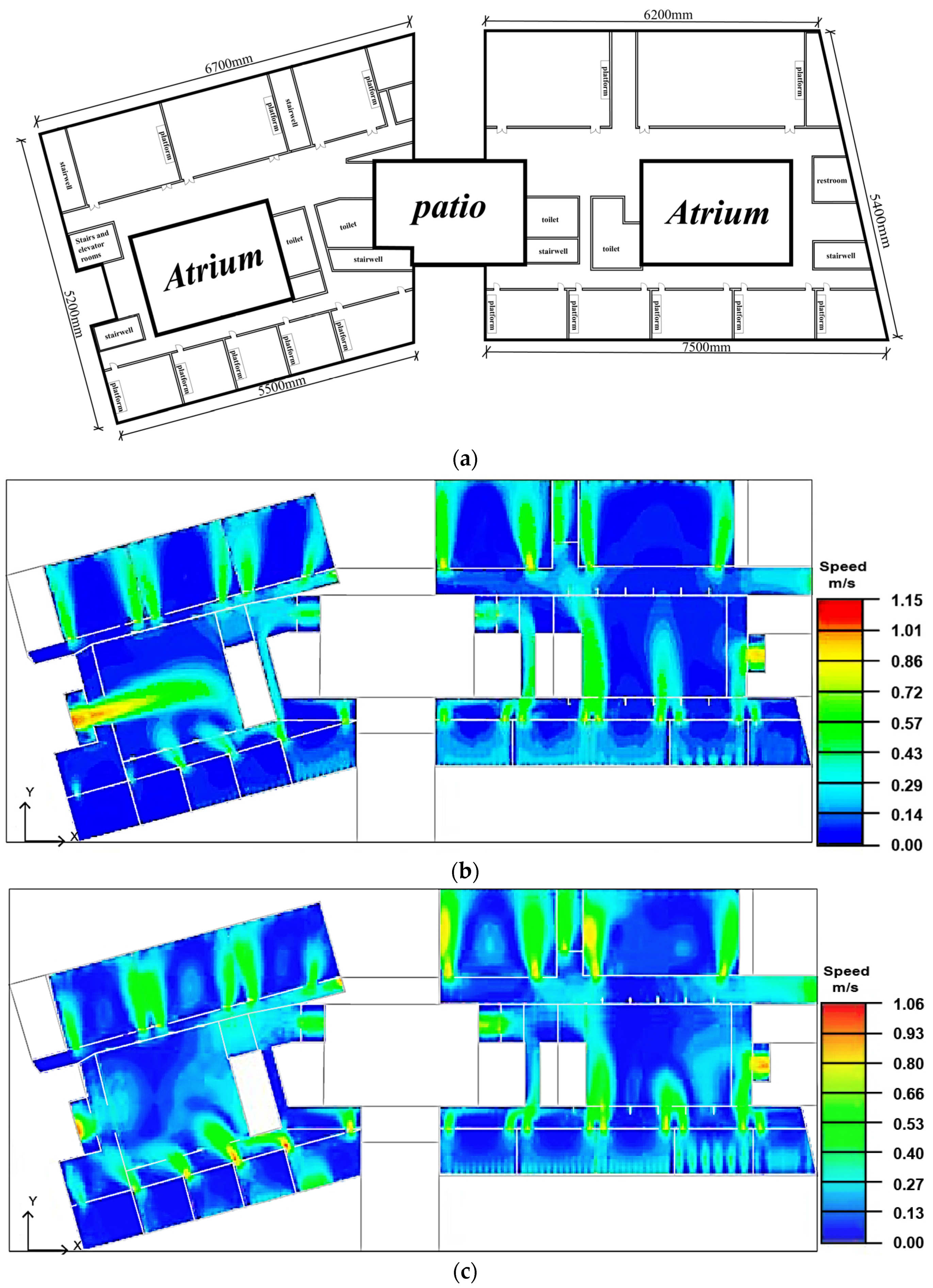
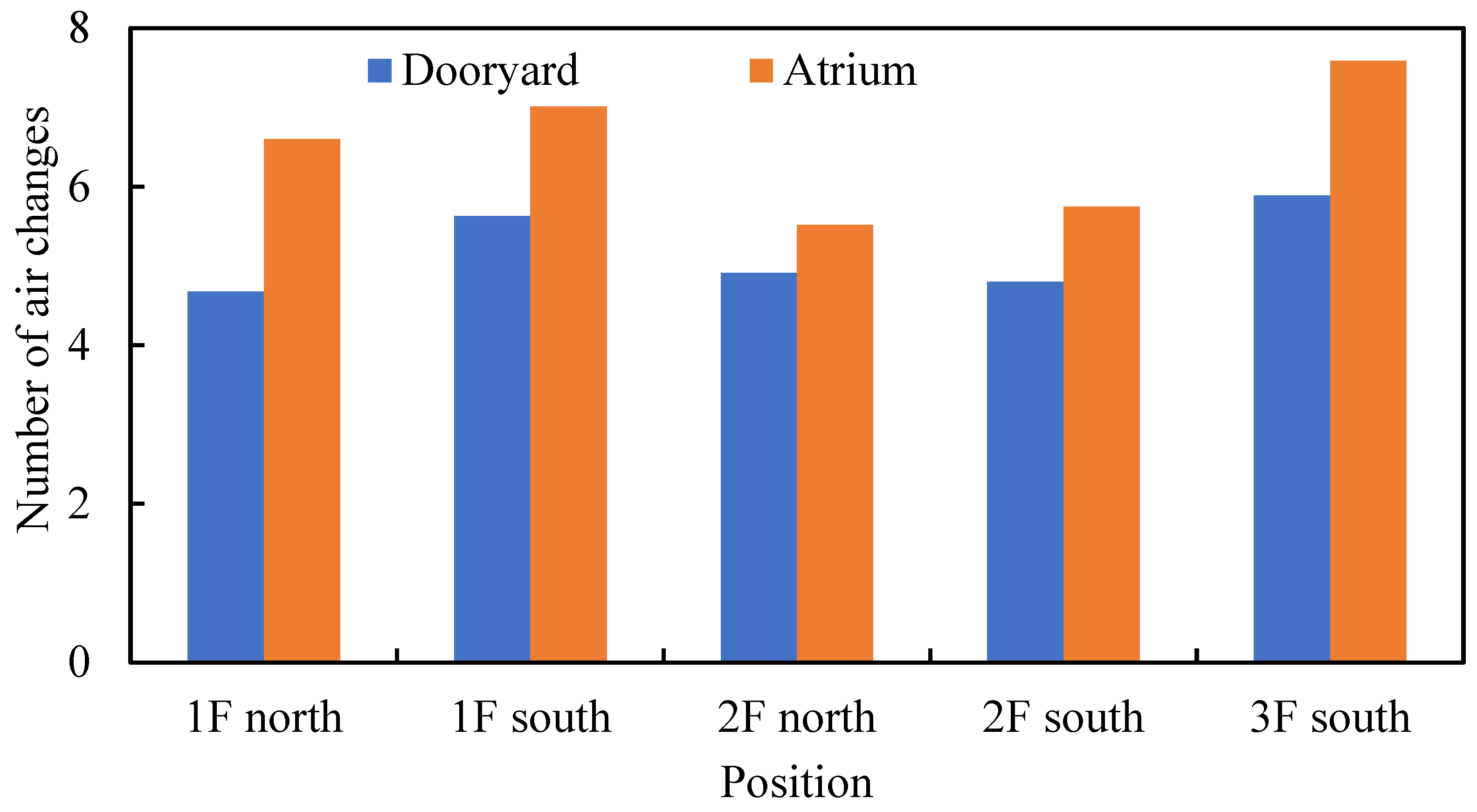
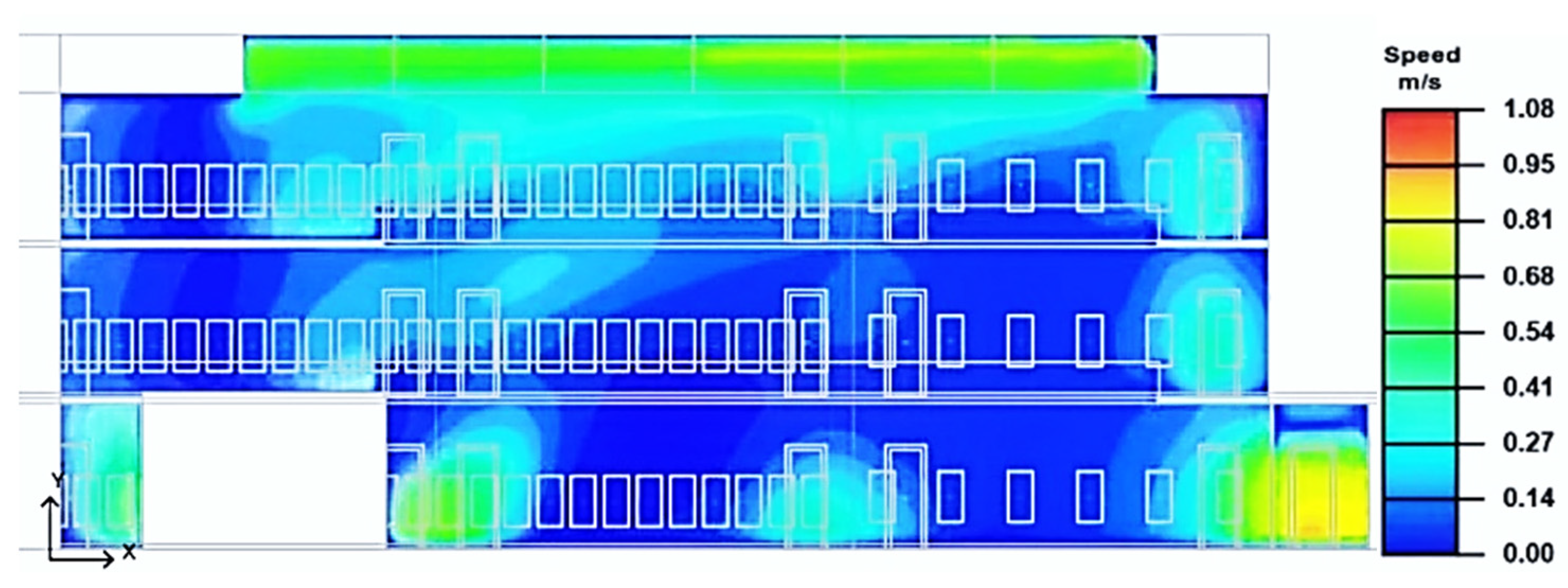

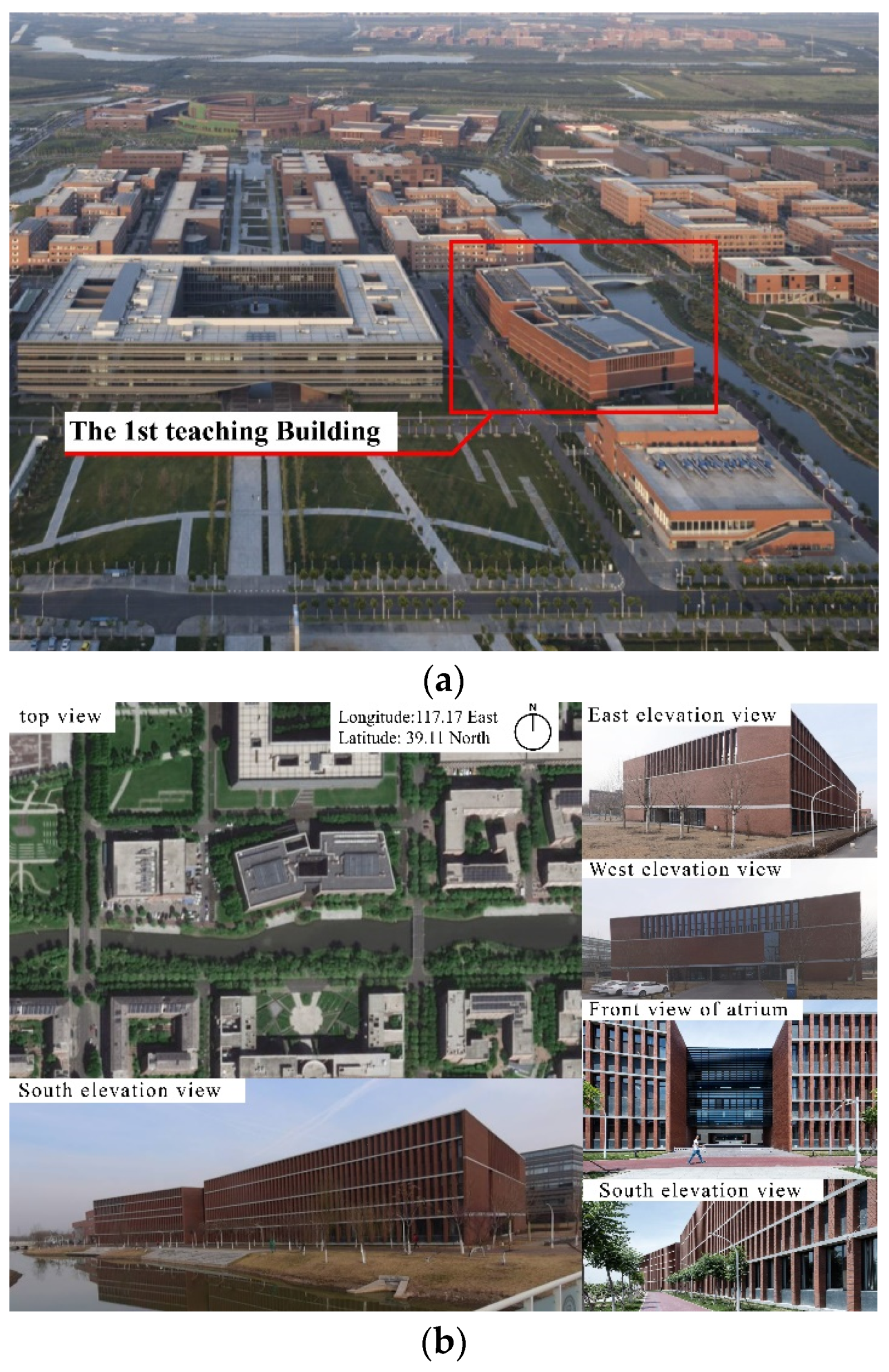
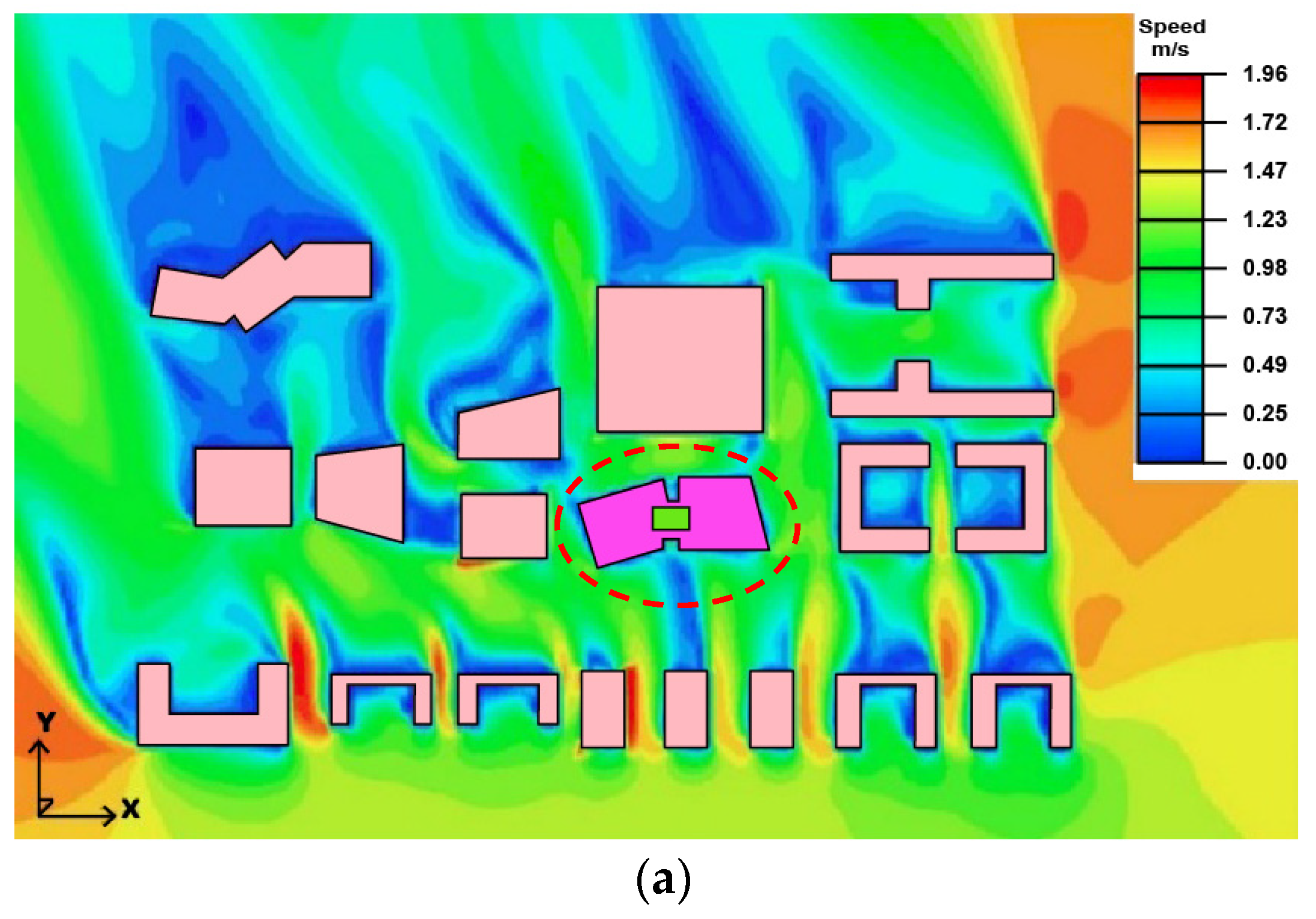
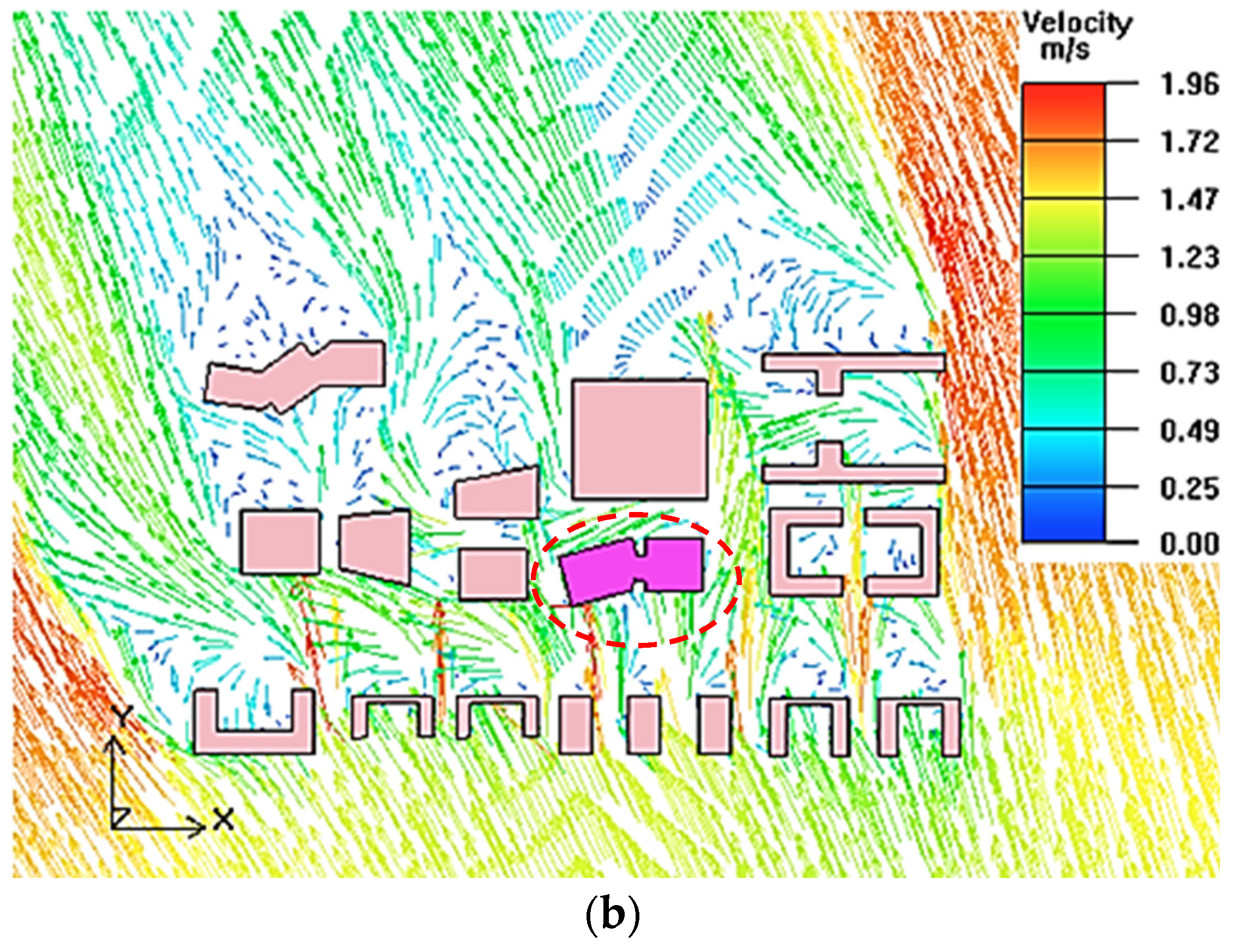
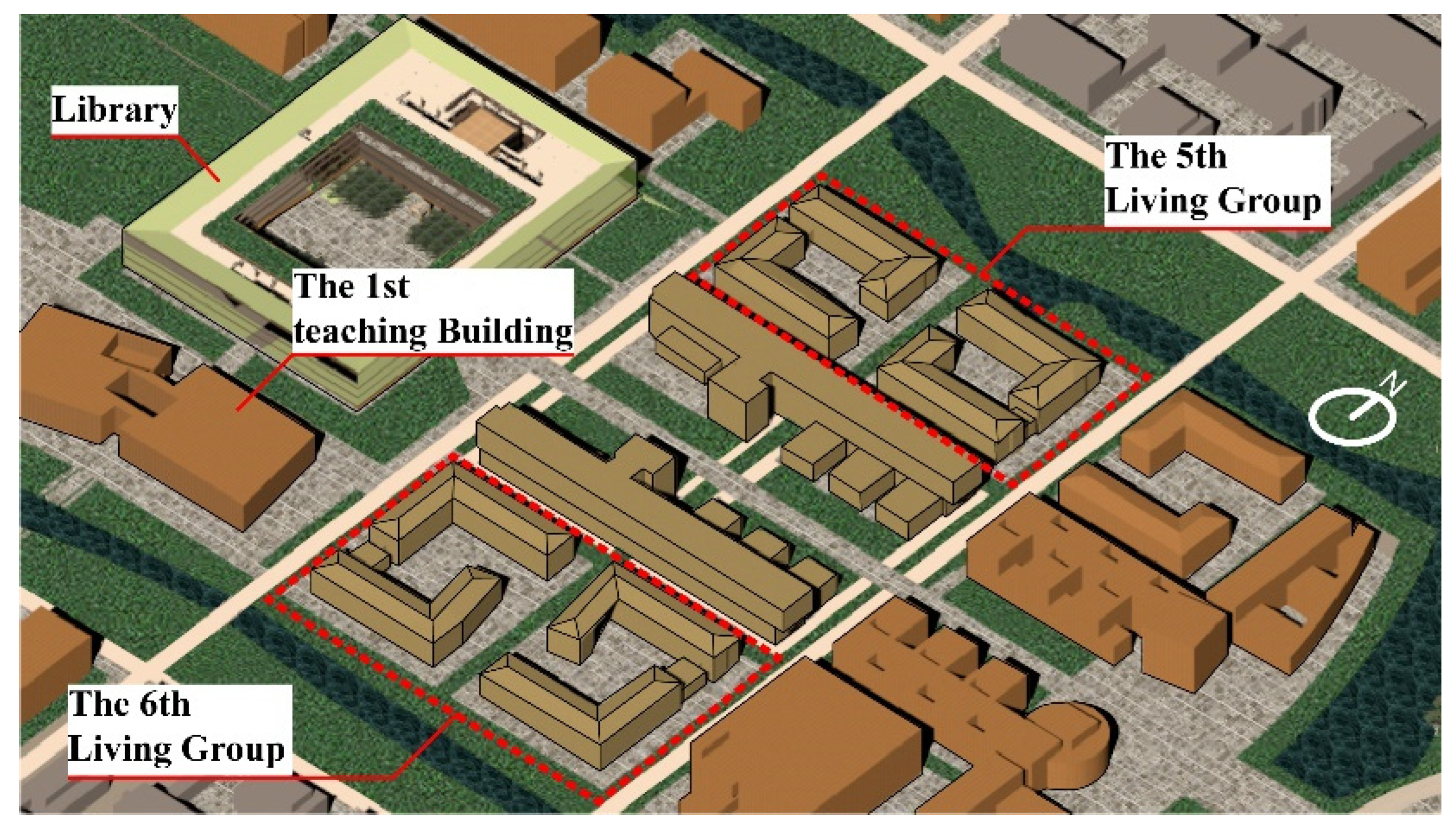



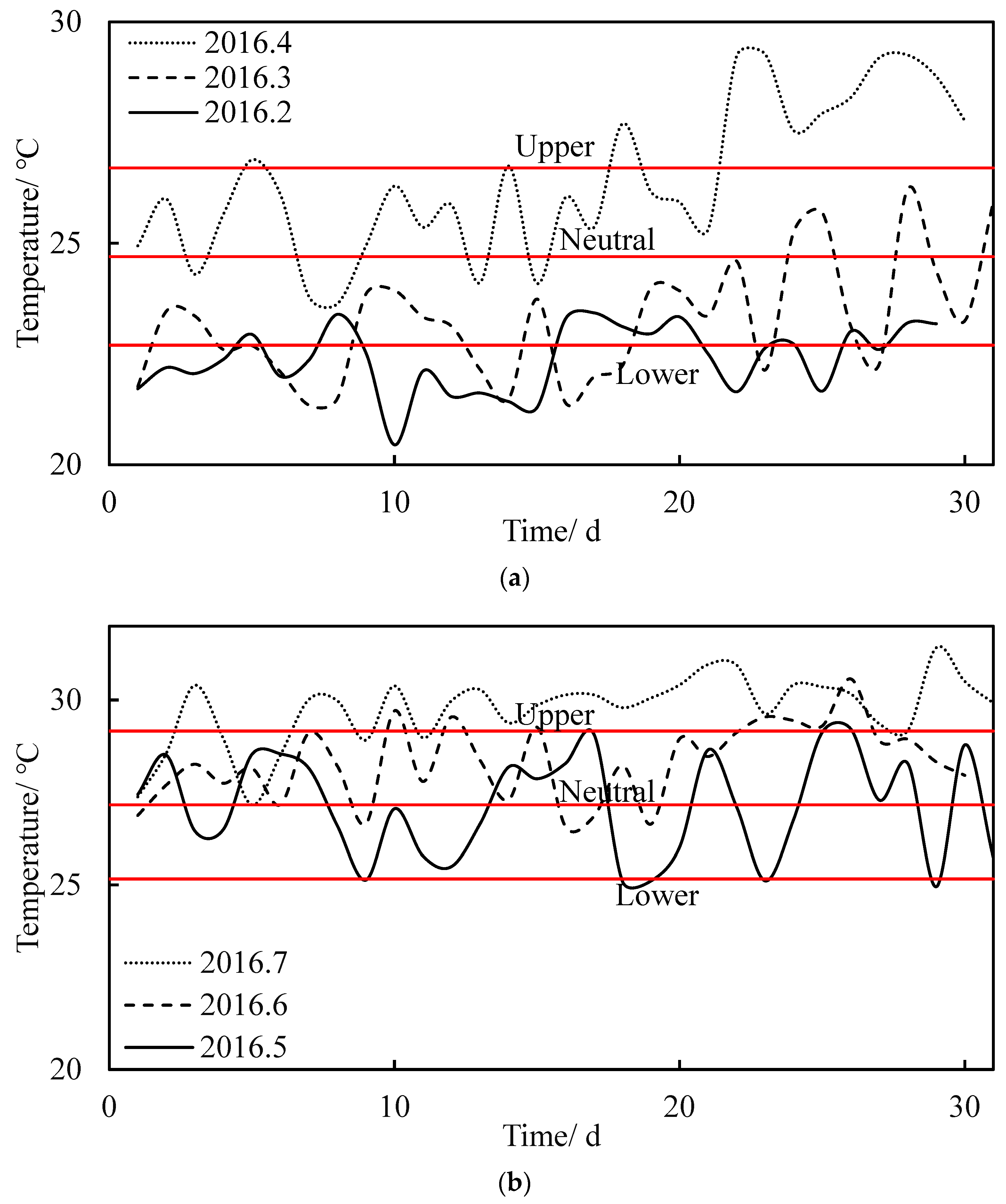
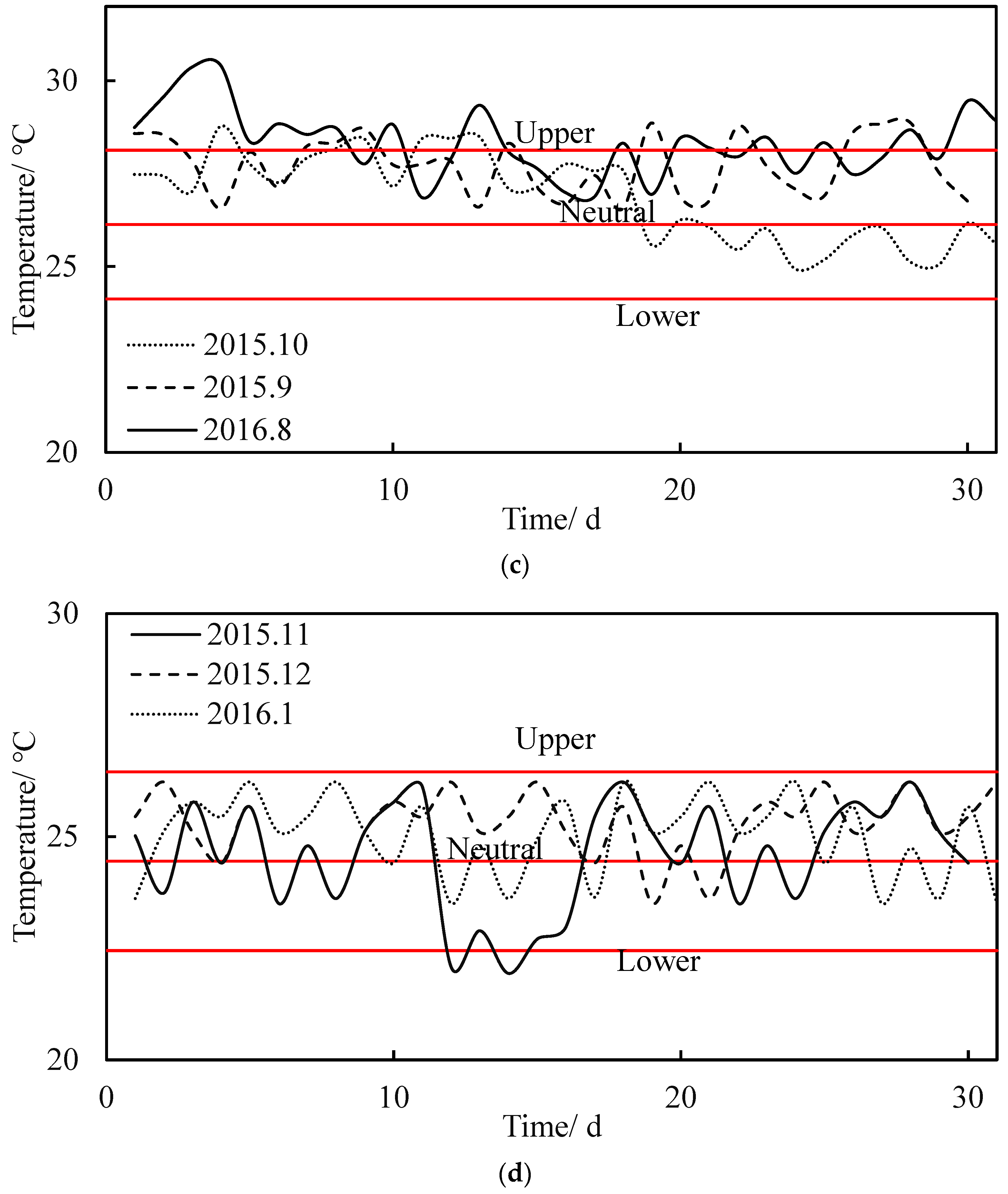
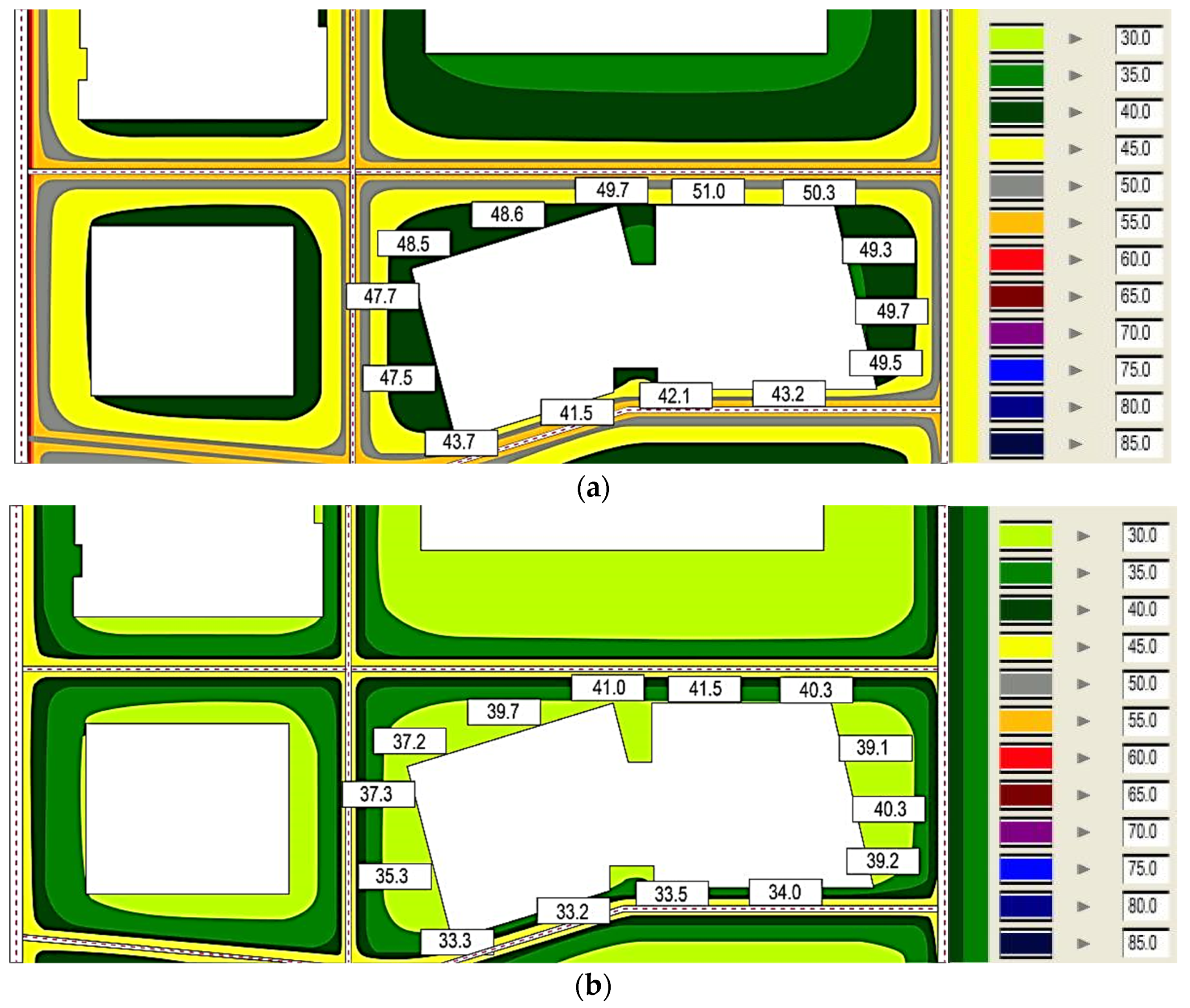




| Model Constant | Value | Model Constant | Value |
|---|---|---|---|
| Cμ | 0.09 | C1ε | 1.44 |
| Cd | 0.1643 | C2ε | 1.92 |
| prK | 1.0 | C3ε | 1.0 |
| prε=K | 1.314 | C | 0.01 |
| Work Conditions | Basic Conditions | Wind Speed (m/s) | Wind Direction | Evaluation Content |
|---|---|---|---|---|
| 1 | 10% gale force winds in summer | 3.0 | South-southeast | Pedestrian comfort |
| 2 | 10% gale force winds in winter | 5.0 | East | Windproof and energy-efficient |
| 3 | Transitional season 10% gale | 4.0 | Southwest | Pedestrian comfort |
| 4 | Average wind speed in summer | 1.7 | South-southeast | Natural ventilation |
| 5 | Average wind speed in winter | 2.9 | East | Wind protection and energy saving |
| 6 | Transitional season average wind speed | 2.2 | Southwest | Natural ventilation |
| Work Conditions | Simulation Wind Velocity (m/s) | Measured Wind Velocity at 1.5 m (m/s) | Wind Speed Amplification Factor | ||
|---|---|---|---|---|---|
| Wind Direction | 10 m | 1.5 m | |||
| 1 | South-southeast | 3.0 | 1.98 | 1.96 | 0.99 |
| 2 | East | 5.0 | 3.29 | 2.96 | 0.90 |
| 3 | Southwest | 4.0 | 2.64 | 2.53 | 0.96 |
| 4 | South-southeast | 1.7 | 1.12 | 1.11 | 0.99 |
| 5 | East | 2.9 | 1.91 | 1.75 | 0.92 |
| 6 | Southwest | 2.2 | 1.45 | 1.39 | 0.96 |
| Daytime | At Night | ||||
|---|---|---|---|---|---|
| Before reconstruction | After reconstruction | Before reconstruction | After reconstruction | ||
| The first teaching building | |||||
| Measured | Measured | Simulated | Measured | Measured | Simulated |
| 68 | 53.4 | 51 | 56 | 42.7 | 41.5 |
| Living area cluster | |||||
| Measured | Measured | Simulated | Measured | Measured | Simulated |
| 63 | 49 | 53 | 45 | 37.4 | 39 |
Disclaimer/Publisher’s Note: The statements, opinions and data contained in all publications are solely those of the individual author(s) and contributor(s) and not of MDPI and/or the editor(s). MDPI and/or the editor(s) disclaim responsibility for any injury to people or property resulting from any ideas, methods, instructions or products referred to in the content. |
© 2023 by the authors. Licensee MDPI, Basel, Switzerland. This article is an open access article distributed under the terms and conditions of the Creative Commons Attribution (CC BY) license (https://creativecommons.org/licenses/by/4.0/).
Share and Cite
Du, X.; Gao, G.; Gao, F.; Zhou, Z. A Study on Modifying Campus Buildings to Improve Habitat Comfort—A Case Study of Tianjin University Campus. Sustainability 2023, 15, 14200. https://doi.org/10.3390/su151914200
Du X, Gao G, Gao F, Zhou Z. A Study on Modifying Campus Buildings to Improve Habitat Comfort—A Case Study of Tianjin University Campus. Sustainability. 2023; 15(19):14200. https://doi.org/10.3390/su151914200
Chicago/Turabian StyleDu, Xinge, Guoyao Gao, Feng Gao, and Zhihua Zhou. 2023. "A Study on Modifying Campus Buildings to Improve Habitat Comfort—A Case Study of Tianjin University Campus" Sustainability 15, no. 19: 14200. https://doi.org/10.3390/su151914200





